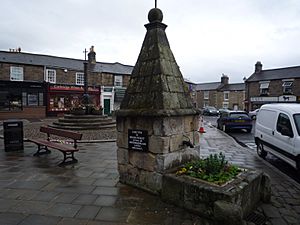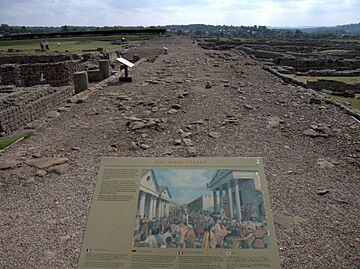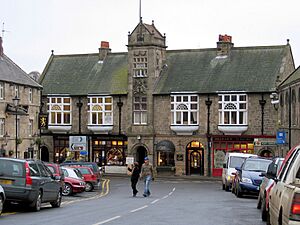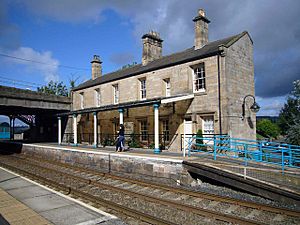Corbridge facts for kids
Quick facts for kids Corbridge |
|
|---|---|
 Market Place, Corbridge town centre |
|
| Population | 3,672 (2011) |
| OS grid reference | NY990646 |
| Civil parish |
|
| Shire county | |
| Region | |
| Country | England |
| Sovereign state | United Kingdom |
| Post town | CORBRIDGE |
| Postcode district | NE45 |
| Dialling code | 01434 |
| Police | Northumbria |
| Fire | Northumberland |
| Ambulance | North East |
| EU Parliament | North East England |
| UK Parliament |
|
| Website | www.visitcorbridge.co.uk |
Corbridge is a lovely village in Northumberland, England. It's about 16 miles (26 km) west of Newcastle and 4 miles (6 km) east of Hexham. You'll find other small villages nearby, like Halton, Acomb, Aydon, and Sandhoe.
Contents
What's in a Name?
Corbridge was known by a different name to the Romans. They called it something like Corstopitum or Coriosopitum. Old wooden writing tablets found at the nearby Roman fort of Vindolanda suggest it might have been called Coria. This name meant a "tribal centre."
The English name Corbridge has changed a bit over time. Early records show it as Corebricg and Colebruge. Experts believe its name is clearly connected to the old Roman name Corstopitum.
Corbridge Through Time
Roman Corbridge: A Busy Town

Corbridge was once the most northern town in the entire Roman Empire. It was a very important place because it sat at the crossing of two major Roman roads: the Stanegate and Dere Street.
The first Roman fort was built here around AD 85. Later, in the mid-2nd century AD, this fort became a town. It had two military areas with walls, and soldiers stayed there until the Romans left the site.
Some of the most famous discoveries from the Roman site include the stone Corbridge Lion statue. There's also the Corbridge Hoard, which is a collection of Roman armour and other items. If you've read Rudyard Kipling's Puck of Pook's Hill, the town of Hunno in the story is probably based on Corbridge.
Today, the Roman Town is looked after by English Heritage. You can visit the site, which has been mostly dug up by archaeologists. There's also a big museum and a shop. It's the top attraction in Corbridge!
Historic Buildings of Corbridge
The Church of England parish church of Saint Andrew is very old. People think it was first opened in 676 AD. Saint Wilfrid is believed to have had it built around the same time as Hexham Abbey. The church has been changed many times over the years. It has a Norman doorway and a special gate called a lychgate. This gate was built to remember those who died in the First World War.
Much of the church is built from stones taken from Hadrian's Wall to the north. The glass doors at the entrance were given by Rowan Atkinson, who is famous for Blackadder and Mr. Bean. They are etched in memory of his mother, who was a church member.
Corbridge is home to one of only three fortified vicarages in the county. A vicarage is where the vicar (church leader) lives. This one, called the Vicar's Pele, was built in the 14th century. It's in the churchyard and has very thick walls, about 1.3 metres (4 feet) wide!
Even older than the Vicar's Pele is Corbridge Low Hall. This building dates back to the late 13th or early 14th century. Part of it was turned into a pele tower in the 15th century. The main part of the building was updated in the 16th and 17th centuries. The old Corbridge Town Hall was designed by Frank Emley and finished in 1887.
In the late 1800s, many beautiful Victorian mansions were built on Prospect Hill. These were for rich business people who could now travel easily to Newcastle by train.
Border Battles
Corbridge, like many other places in the area, suffered from fighting along the border. This was especially common between 1300 and 1700. Raids were frequent. It was normal for farm animals to be brought into the town at night for safety. People would also watch both ends of the street to guard against attackers.
A bridge over the River Tyne was built in the 13th century, but it didn't last. The current bridge is an impressive stone structure with seven arches. It was built in 1674 and is still used today.
How Corbridge is Run
Corbridge is part of the Hexham area for the UK Parliament. The local Member of Parliament (MP) is Joe Morris from the Labour Party.
For local matters, Corbridge is part of Northumberland County Council. This council manages services for the whole county. There's also a local group called Corbridge Parish Council. This council has 10 members who are elected every four years. They choose one person to be their Chairman for a year. The council meets once a month at Corbridge Parish Hall.
Getting Around Corbridge
Corbridge has good transport links. The A69 road goes around the north of the village. This road connects Corbridge to Newcastle and Carlisle. The A695 road also links Corbridge to Newcastle and the A1. This road passes about 1 mile (1.6 km) south of the village, on the other side of the River Tyne.
- Buses
You can catch buses like the 684, 685, and Tyne Valley 10. These routes connect Corbridge to Newcastle and Hexham. The 685 service also goes to Carlisle.
- Trains
Corbridge has its own train station, called Corbridge railway station. It's on the Newcastle & Carlisle Railway, also known as the Tyne Valley line. This train line opened in 1838. It connects Newcastle with Carlisle and follows the River Tyne through Northumberland.
Passenger trains on this line are run by a company called Northern. The line is also used for freight trains, which carry goods. The railway station is about 1 mile (1.6 km) south of the village, across the River Tyne.
Fun Events in Corbridge
Corbridge hosts several fun events throughout the year!
Stagshaw Bank Fair was once a very famous country fair. It used to be held every year on July 4th. It was a huge event where lots of farm animals were sold.
The Northumberland County Show is a big farming event. It used to be held in the fields outside Corbridge every year. In 2013, it moved to Bywell.
The Corbridge Steam Fair and Vintage Rally happens every June. It's a celebration of amazing steam engines. You can also see classic cars, trucks, and tractors there.
The Corbridge Festival has been running since 2011. It usually takes place on the last weekend of June or the first weekend of July. Famous bands like The Coral and Fun Lovin' Criminals have performed there. The festival now has three stages and features up to 50 bands!
A Midsummer’s Evening in Corbridge celebrates the longest day of the year. Performers, stalls, and late-night shopping fill the village from 4 PM to 9 PM.
Every year on the first Monday in December, the village hosts Christmas in Corbridge. This event includes carol singing, food stalls, and late-night shopping. It's a great way to get into the festive spirit!
Famous Faces from Corbridge
Many interesting people have connections to Corbridge:
- Born in Corbridge
- Alan Brown (1914–1996), a professional footballer and manager.
- Graham Carr (born 1944), a professional footballer, manager, and scout.
- Steve Bruce (born 1960), a professional footballer and manager.
- John Blackburn (1923–1993), a writer known for thriller novels.
- Maggie Telfer (1959–2023), a health activist.
- Lived in Corbridge
- Dame Catherine Cookson (1906–1998), a very popular author.
- Carol Malia, a presenter for BBC Look North.
- Rachel Unthank, a folk musician.
- Ruth Ainsworth (1908–1984), a children's writer.





